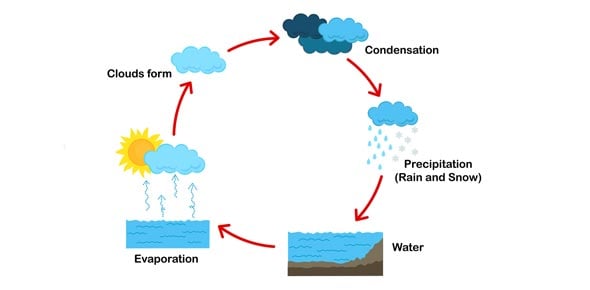6th The Water Cycle

This quiz will help test your knowledge of the Water Cycle.
- 1.
What is another name for precipitation?
- A.
Clouds
- B.
Sunlight
- C.
Rain
Correct Answer
C. RainExplanation
Precipitation refers to any form of water that falls from the atmosphere to the Earth's surface. This can include rain, snow, sleet, or hail. Among the options given, rain is the only one that fits this definition and is commonly associated with precipitation. Clouds are the visible masses of condensed water vapor, while sunlight refers to the electromagnetic radiation emitted by the sun. Therefore, the correct answer is rain.Rate this question:
-
- 2.
Condensation occurs when...
- A.
Rain falls on lakes and rivers.
- B.
Vapor in the air cools and changes back into liquid to form clouds
- C.
Clouds appear
- D.
Rain forms clouds
Correct Answer
B. Vapor in the air cools and changes back into liquid to form cloudsExplanation
Condensation occurs when vapor in the air cools and changes back into liquid to form clouds. This process happens when the warm air containing water vapor comes into contact with a cooler surface or air mass. As the air cools, it loses its ability to hold the moisture, causing the water vapor to condense into tiny droplets or ice crystals, forming clouds. This is a natural phenomenon that plays a crucial role in the water cycle and weather patterns.Rate this question:
-
- 3.
When clouds get heavy what happens next?
- A.
It rains
- B.
It gets windy
- C.
Clouds fall to earth
- D.
Rivers and lakes overflow
Correct Answer
A. It rainsExplanation
When clouds get heavy, it indicates that they are saturated with moisture. As a result, the excess moisture in the clouds condenses into water droplets and falls to the ground in the form of rain. Therefore, the correct answer is "it rains".Rate this question:
-
- 4.
What are the main features of the water cycle?
- A.
Precipitation, evaporation
- B.
Precipitation, respiration, condensation
- C.
Evaporation, precipitation, condensation
Correct Answer
C. Evaporation, precipitation, condensationExplanation
The water cycle consists of three main processes: evaporation, precipitation, and condensation. Evaporation occurs when water changes from a liquid state to a gas, typically due to heat from the sun. Precipitation refers to the process of water vapor condensing into liquid or solid form and falling to the Earth's surface as rain, snow, sleet, or hail. Finally, condensation occurs when water vapor cools and changes back into liquid form, forming clouds. These three processes work together to continuously circulate water on Earth, making them the main features of the water cycle.Rate this question:
-
- 5.
What is the driving force of the water cycle
- A.
Batteries
- B.
Sun
- C.
Ocean
Correct Answer
B. SunExplanation
The sun is the driving force of the water cycle. It provides the energy needed to evaporate water from the Earth's surface, causing it to rise into the atmosphere. As the water vapor cools, it condenses into clouds and eventually falls back to the Earth as precipitation. This continuous cycle is powered by the heat and radiation from the sun, making it the main driving force behind the water cycle.Rate this question:
-
- 6.
What do we call any form of water that falls to the earth?
- A.
Hail
- B.
Precipitation
- C.
Evaporation
Correct Answer
B. PrecipitationExplanation
Precipitation refers to any form of water that falls to the earth, such as rain, snow, sleet, or hail. It is the result of the condensation of water vapor in the atmosphere, which then forms into droplets or ice crystals that become heavy enough to fall. Evaporation, on the other hand, is the process by which water changes from a liquid to a gas, usually due to heating. Hail is a specific type of precipitation that consists of ice pellets that form in thunderstorm updrafts.Rate this question:
-
Quiz Review Timeline +
Our quizzes are rigorously reviewed, monitored and continuously updated by our expert board to maintain accuracy, relevance, and timeliness.
-
Current Version
-
Mar 21, 2023Quiz Edited by
ProProfs Editorial Team -
Nov 07, 2018Quiz Created by
Ccraig
 Back to top
Back to top


